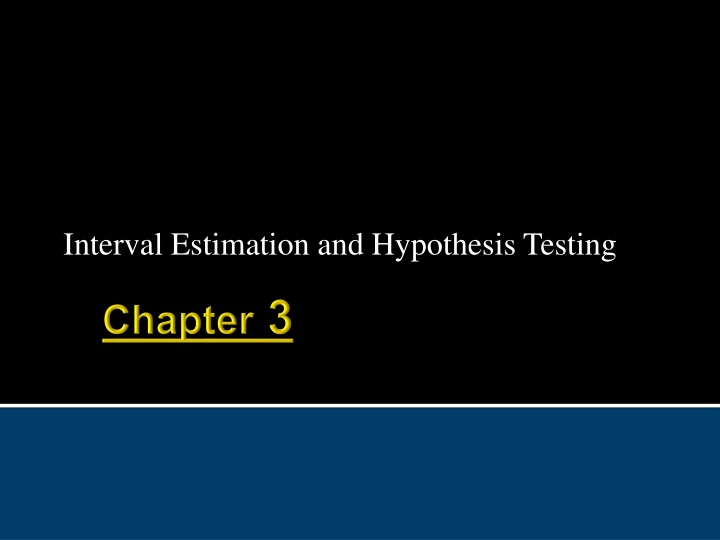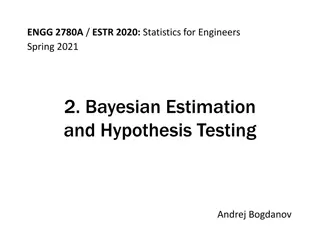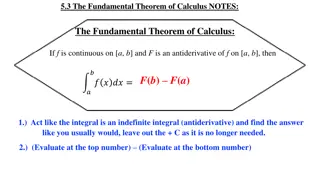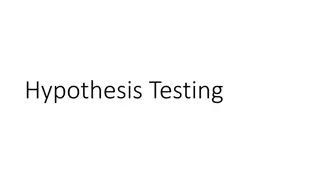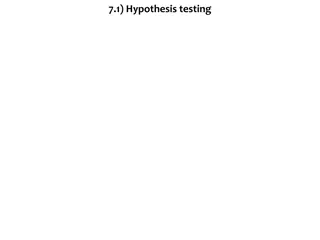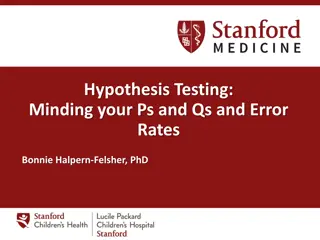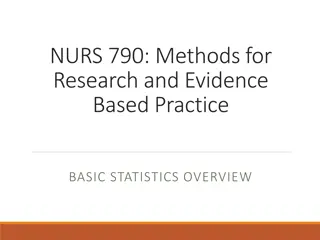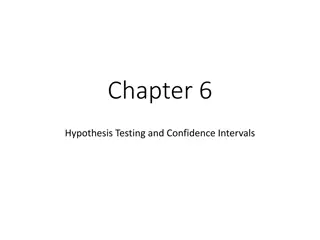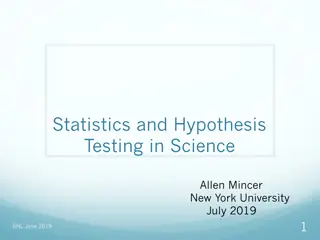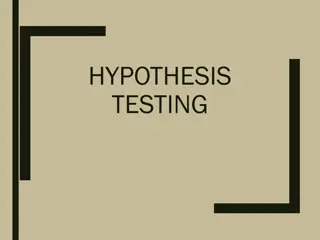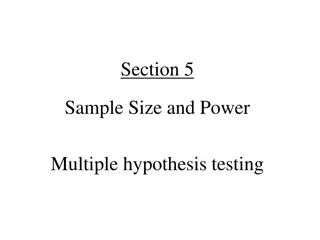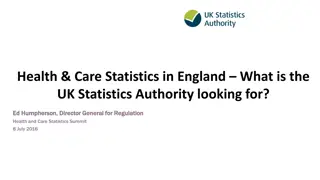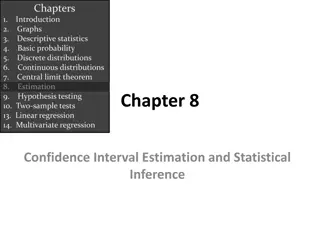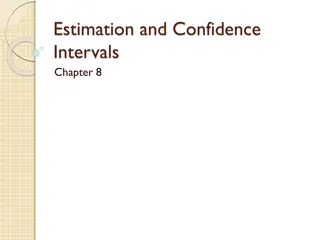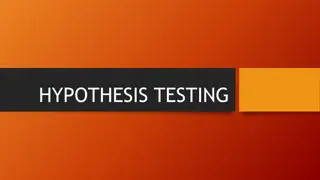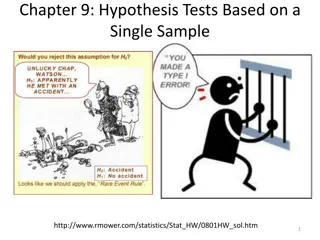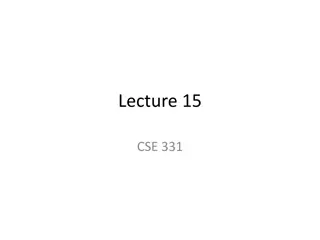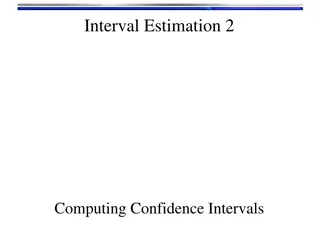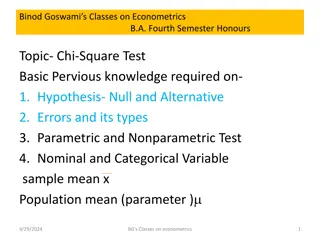Interval Estimation and Hypothesis Testing in Statistics
The concept of interval estimation and hypothesis testing in statistics involves techniques such as constructing interval estimators, performing hypothesis tests, determining critical values from t-distributions, and making probability statements. Assumptions must be met in linear regression models for accurate estimation. The t-distribution, with degrees of freedom influencing its shape, plays a crucial role in statistical inference.
Download Presentation

Please find below an Image/Link to download the presentation.
The content on the website is provided AS IS for your information and personal use only. It may not be sold, licensed, or shared on other websites without obtaining consent from the author.If you encounter any issues during the download, it is possible that the publisher has removed the file from their server.
You are allowed to download the files provided on this website for personal or commercial use, subject to the condition that they are used lawfully. All files are the property of their respective owners.
The content on the website is provided AS IS for your information and personal use only. It may not be sold, licensed, or shared on other websites without obtaining consent from the author.
E N D
Presentation Transcript
3.1 Interval Estimation 3.2 Hypothesis Tests 3.3 Rejection Regions for Specific Alternatives 3.4 Examples of Hypothesis Tests
Assumptions of the Simple Linear Regression Model = + + y E e = var( ) cov( , x e SR1. SR2. SR3. SR4. SR5. The variable x is not random, and must take at least two different values. SR6. (optional) The values of e are normally distributed about their mean 1 2 = + y ) y y i j ( ) 0 = = ) e e i j ( ) var( ) cov( , E y x 1 2 2 e = = 0 2 ~ ( , 0 ) e N
( ) The two endpoints provide an interval estimator. ( 2 1.96 b x ) 2 2 x i In repeated sampling 95% of the intervals constructed this way will contain the true value of the parameter 2. This easy derivation of an interval estimator is based on the assumption SR6 and that we know the variance of the error term 2.
2 Replacing 2with creates a random variable t: b b b = = = 2 2 2 2 2 2 ~ t t ( ) b (3.2) ( 2) N se ( ) ( ) b 2 2 x x var 2 i 2 The ratio has a t-distribution with (N 2) degrees of freedom, ( ) ( ) 2 2 2 se t b b = ~ N t t which we denote as . ( 2)
In general we can say, if assumptions SR1-SR6 hold in the simple linear regression model, then b = = k k ~ for 1,2 t t k ( ) b (3.3) ( ) 2 N se k The t-distribution is a bell shaped curve centered at zero. It looks like the standard normal distribution, except it is more spread out, with a larger variance and thicker tails. The shape of the t-distribution is controlled by a single parameter called the degrees of freedom, often abbreviated as df.
We can find a critical value from a t-distribution such that ( ) ( ) = = 2 P t t P t t c c where is a probability often taken to be = .01 or = .05. t The critical value tcfor degrees of freedom m is the percentile value . ( ) 1 2,m
Each shaded tail area contains /2 of the probability, so that 1 of the probability is contained in the center portion. Consequently, we can make the probability statement ) 1 = ( P t t t (3.4) c c b ] 1 = k k [ P t t c c se( ) b k + = [ se( ) b se( )] 1 k b P b t b t (3.5) k c k k k c
For the food expenditure data + = [ 2.024se( ) 2.024se( )] .95 b P b b b (3.6) 2 2 2 2 2 The critical value tc= 2.024, which is appropriate for = .05 and 38 degrees of freedom. To construct an interval estimate for 2we use the least squares estimate b2= 10.21 and its standard error = = = se( ) b var( ) 4.38 2.09 b 2 2
A 95% confidence interval estimate for 2: se( ) 10.21 2.024(2.09)=[5.97,14.45] b = b t 2 2 c When the procedure we used is applied to many random samples of data from the same population, then 95% of all the interval estimates constructed using this procedure will contain the true parameter.
Components of Hypothesis Tests A null hypothesis, H0 An alternative hypothesis, H1 1. 2. 3. A test statistic A rejection region 4. A conclusion 5.
The Null Hypothesis The null hypothesis, which is denoted H0(H-naught), specifies a value for a regression parameter. The null hypothesis is stated , where c is a constant, and is an important k H c = 0: value in the context of a specific regression model.
The Alternative Hypothesis Paired with every null hypothesis is a logical alternative hypothesis, H1, that we will accept if the null hypothesis is rejected. For the null hypothesis H0: k= c the three possible alternative hypotheses are: 1: H c k 1: H c k 1: H c k
The Test Statistic ( k t b = ) se( ) ~ b t ( 2) k k N = If the null hypothesis is true, then we can substitute c for kand it follows that 0: H c k b c = k ~ t t (3.7) ( 2) N se( ) b k If the null hypothesis is not true, then the t-statistic in (3.7) does not have a t- distribution with N 2 degrees of freedom.
The Rejection Region The rejection region depends on the form of the alternative. It is the range of values of the test statistic that leads to rejection of the null hypothesis. It is possible to construct a rejection region only if we have: a test statistic whose distribution is known when the null hypothesis is true an alternative hypothesis a level of significance The level of significance is usually chosen to be .01, .05 or .10.
A Conclusion We make a correct decision if: The null hypothesis is false and we decide to reject it. The null hypothesis is true and we decide not to reject it. Our decision is incorrect if: The null hypothesis is true and we decide to reject it (a Type I error) The null hypothesis is false and we decide not to reject it (a Type II error)
3.3.1. One-tail Tests with Alternative Greater Than (>) 3.3.2. One-tail Tests with Alternative Less Than (<) 3.3.3. Two-tail Tests with Alternative Not Equal To ( )
Figure 3.2 Rejection region for a one-tail test of H0: k= c against H1: k> c
= When testing the null hypothesis against the 0: H c k alternative hypothesis , reject the null hypothesis k H 1: c and accept the alternative hypothesis if . t t ( ) 1 , 2 N
Figure 3.3 The rejection region for a one-tail test of H0: k= c against H1: k< c
= When testing the null hypothesis against the 0: H c k alternative hypothesis , reject the null hypothesis k H 1: c and accept the alternative hypothesis if . t t ( ) , 2 N
Figure 3.4 The rejection region for a two-tail test of H0: k= c against H1: k c
= When testing the null hypothesis against the 0: H c k alternative hypothesis , reject the null hypothesis k H 1: c and accept the alternative hypothesis if or if t t ( ) 2, 2 N . t t ( ) 1 2, 2 N
STEP-BY-STEP PROCEDURE FOR TESTING HYPOTHESES 1. Determine the null and alternative hypotheses. 2. Specify the test statistic and its distribution if the null hypothesis is true. 3. Select and determine the rejection region. 4. Calculate the sample value of the test statistic. 5. State your conclusion.
